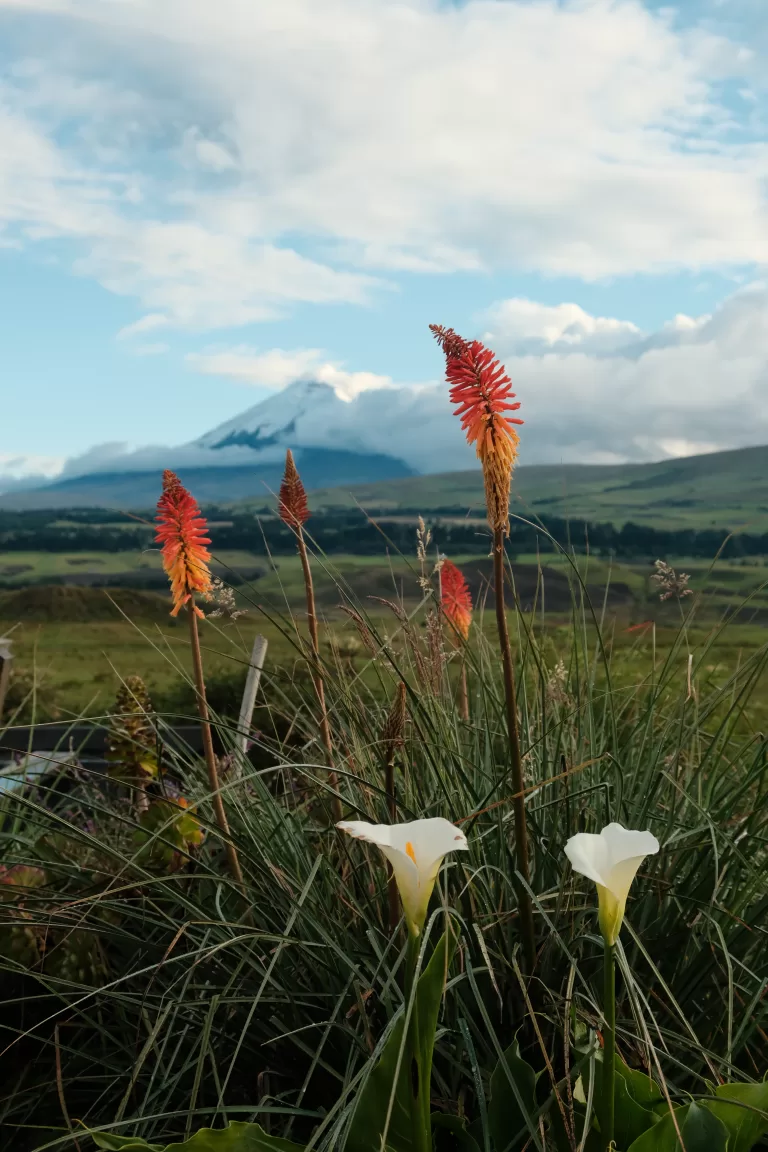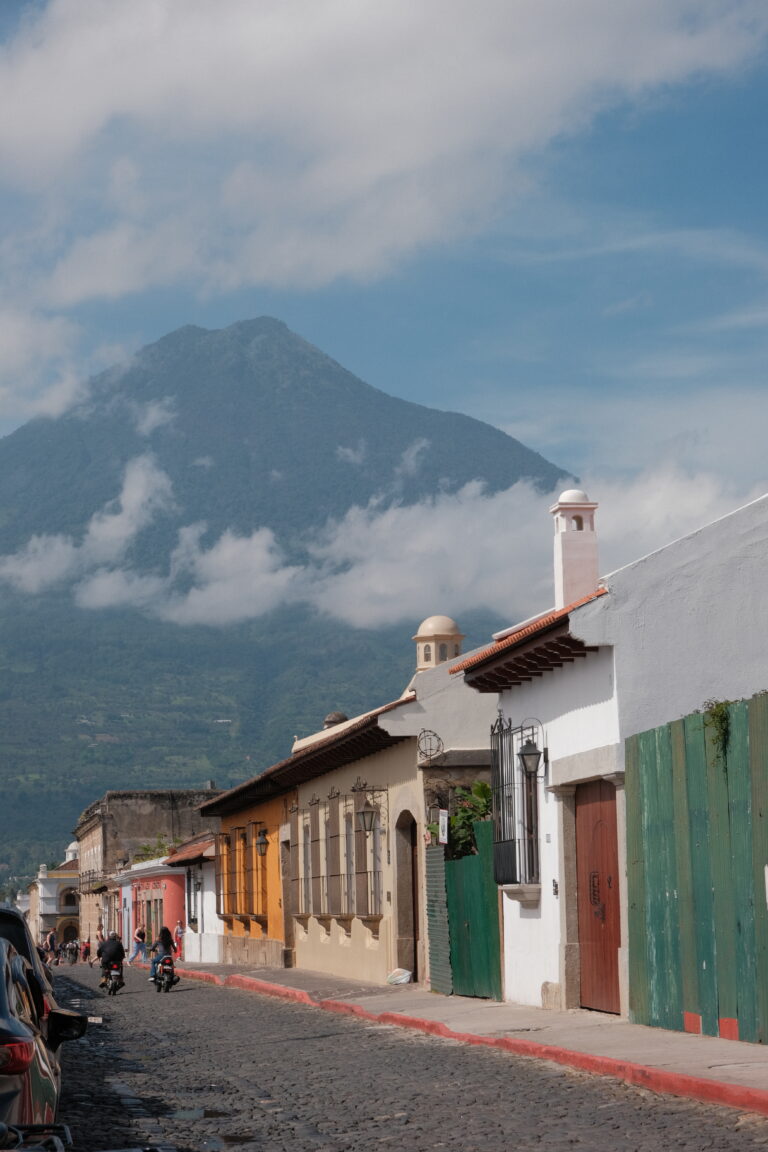Earlier this year, I visited the beautiful country of Ecuador for the first time. My boyfriend happens to be from Ecuador, and this was his first trip back since he moved to the US as a child. We went with his family, who wanted to see all the main sites that they didn’t get to see when they lived there. They also wanted to rent a car so we would have the flexibility and freedom to do whatever we wanted on the trip, without having to take lengthy tours everyday. With their help and a little research I planned this busy 10-day Ecuador itinerary, which includes stops at Ecuador’s capital city, two impressive volcanos, a crater lake, and a towering waterfall.
When I was planning this trip, I was surprised at how little information there is about traveling in Ecuador, and especially doing a roadtrip around the country. Most people who visit will just stay in the capital, Quito, and do guided tours from there, before heading off to the Galapagos (unfortunately I didn’t make it to the Galapagos this trip, but it is top of the list for our next trip).
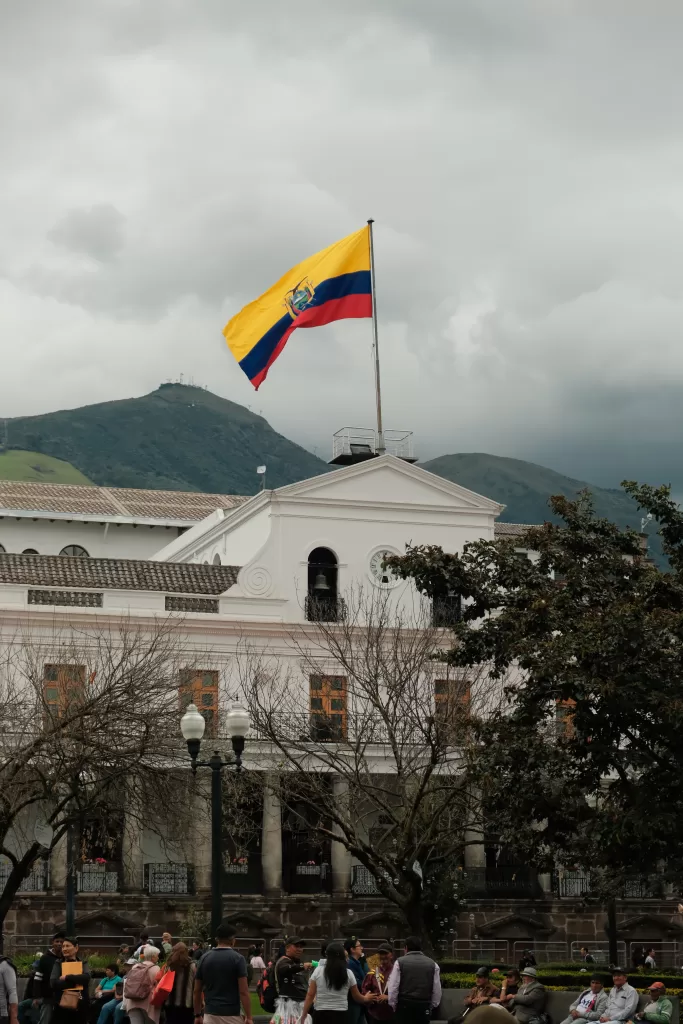
But if you are comfortable renting a car and driving in a foreign country, I would highly recommend traveling around Ecuador via a roadtrip. It will allow you to slow down and spend more time in each place, and dive deeper into the culture and natural wonders that the country has to offer. Since Ecuador is a relatively small country, you can see so many sites without doing too much driving each day. Most stops are about 2-3 hours away from each other. In total this itinerary requires about 12 hours of driving spread out over the 10 days, so its really not that bad!
This comprehensive 9-night, 10-day Ecuador Roadtrip itinerary focuses on the Andes region, stopping in the capital of Quito, Cotopaxi National Park, Quilotoa, Baños and Riobamba. I provide information on each of the 5 stops, including where to stay, things to do, and important tips you should know. I hope this itinerary inspires you to explore the underrated country of Ecuador!
Renting a Car in Ecuador
This itinerary requires that you rent a car in Quito and drive between cities and attractions, including on some unpaved roads. Keep reading to see my thoughts on driving in Ecuador and an alternative route without a car.
Is it Safe to Drive in Ecuador?
If you’ve visited a Latin American country and rode in a car there, you’d know that there are a lot less traffic rules there than in the United States or Europe. However, I don’t think that makes the roads less safe. You just have to be very aware. Drive defensively and stay alert. I didn’t personally drive in Ecuador as I was with my boyfriend who is a much better driver than me. He didn’t have any problems on the roads, and was able to use Google Maps and Waze to navigate.
Most of this roadtrip follows Ecuador Highway 35, or the Pan American Highway, with detours to get to each stop. You will encounter some unpaved, bumpy roads particularly around Cotopaxi National Park. This is why we recommend getting a 4 wheel drive SUV. Our rental car was a Renault Duster and we honestly couldn’t have asked for a better car. We had no issues and were able to get back our full deposit when returning the car.
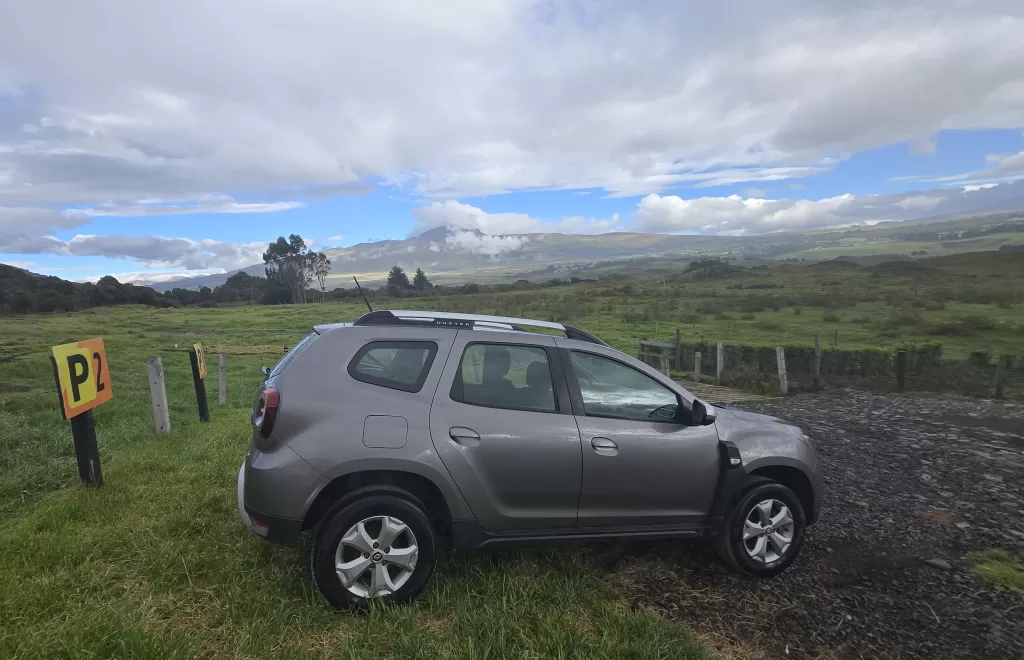
Use DiscoverCars to compare car rental prices in Ecuador.
Do you need a car the whole time you’re in Ecuador?
While you’re in Quito, you technically don’t need a car. Parking in the city is not easy and there’s always a risk of a break in, so it’s best to wait until you are leaving Quito instead of renting it at the airport. We rented our car with the company Enterprise since they had a pickup location close to our hotel in Quito, where we picked up, and one at the Quito airport, where we dropped off.
Ubers are inexpensive, quick and safe in Quito so you should use that for getting from the airport to the city and for travel around the city.
Can you do this Ecuador itinerary without a car?
Yes, you can use buses to get to all the cities in this itinerary. However, the better alternative is to stay in Quito and do day trips to other destinations, like Cotopaxi, Quilatoa and Banos. Check out these high rated tours on GetYourGuide that let you explore Ecuador without the stress.
If you want to stay overnight in Cotopaxi, you can easily stay at the Secret Garden just as explained in my itinerary, as they have a free shuttle that takes you from their location in Quito to Cotopaxi. The Secret Garden also offers tours and transport to various places throughout the country, like the Amazon Rainforest, Quilotoa and Chimborazo.
As for using public transportation to get around the country, I’ve heard mixed things about the safety of buses in Ecuador. Supposedly there are a lot of pickpockets on the buses. If you’re taking an overnight bus, avoid leaving valuables on the floor while you’re sleeping, as thieves will crawl around the floor cutting open bags. I haven’t taken the buses so I can’t personally recommend them.
Wanderbus Ecuador is a good company if you want to do an unstructured, budget-friendly tour in Ecuador. They aren’t exactly “guided tours” but instead safe bus transport from city to city which include fun stops along the way. You can choose your days of transport based on how long you want to spend in each place, so it is very customizable. I think it’s a great alternative to taking the public buses, especially if you are traveling solo!
Currency in Ecuador
Ecuador uses the US Dollar (USD) as its official currency, so if you’re coming from the US you won’t have to worry about exchanging any money!
Many businesses in the smaller towns, including restaurants and hotels, are cash-only, so make sure you carry a good amount with you on this roadtrip. It’s also good to have small bills and coins, because some places won’t accept big bills.
Getting to Ecuador
This itinerary starts and ends in Quito, Ecuador, which has lots of direct flights from the US on airlines like Jetblue and Avianca. Search for flights here on Booking.com.
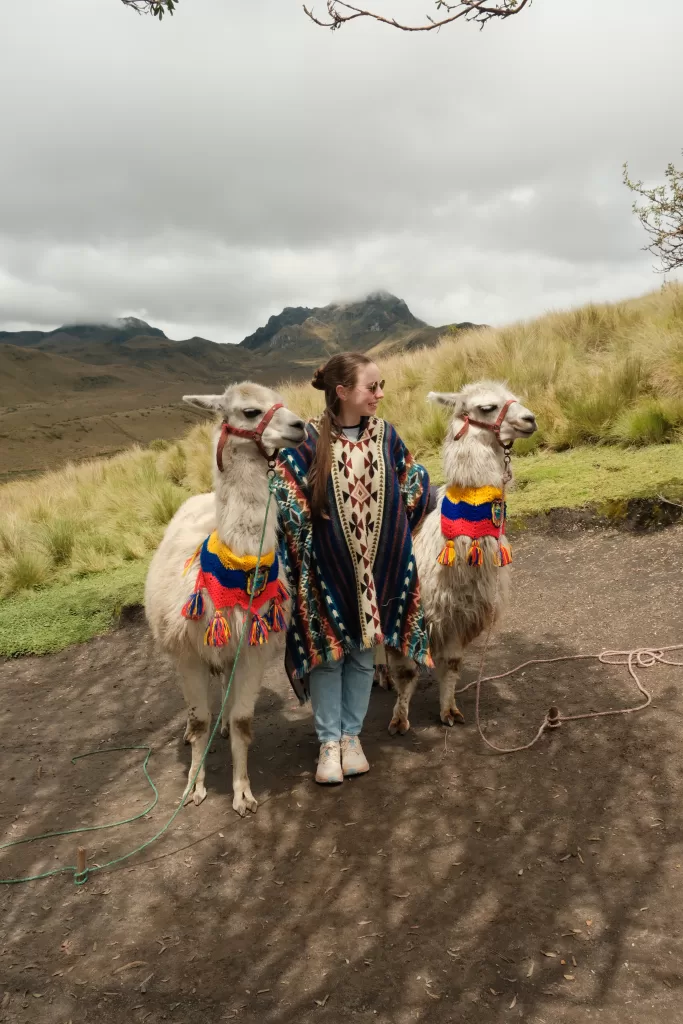
The 10-day Ecuador
Roadtrip Itinerary
- Quito – 2 nights
- Cotopaxi – 2 nights
- Quilotoa – 1 night
- Baños – 2 nights
- Riobamba– 2 nights
Quito
Stay 2 nights
Your Ecuador adventure will start in Quito, which is the capital of Ecuador. Quito is nestled in the Andes mountains at an altitude of 2,850 meters and is a designated UNESCO World Heritage Site. In Quito’s beautiful historic center, you’ll find Spanish colonial architecture, cobblestone streets and big beautiful plazas. There’s lots to do in and around the city, making it a good base for travelers wanting to explore Ecuador. We particularly liked that Quito had a good mix of preserved colonial architecture and history, along with modern amenities.
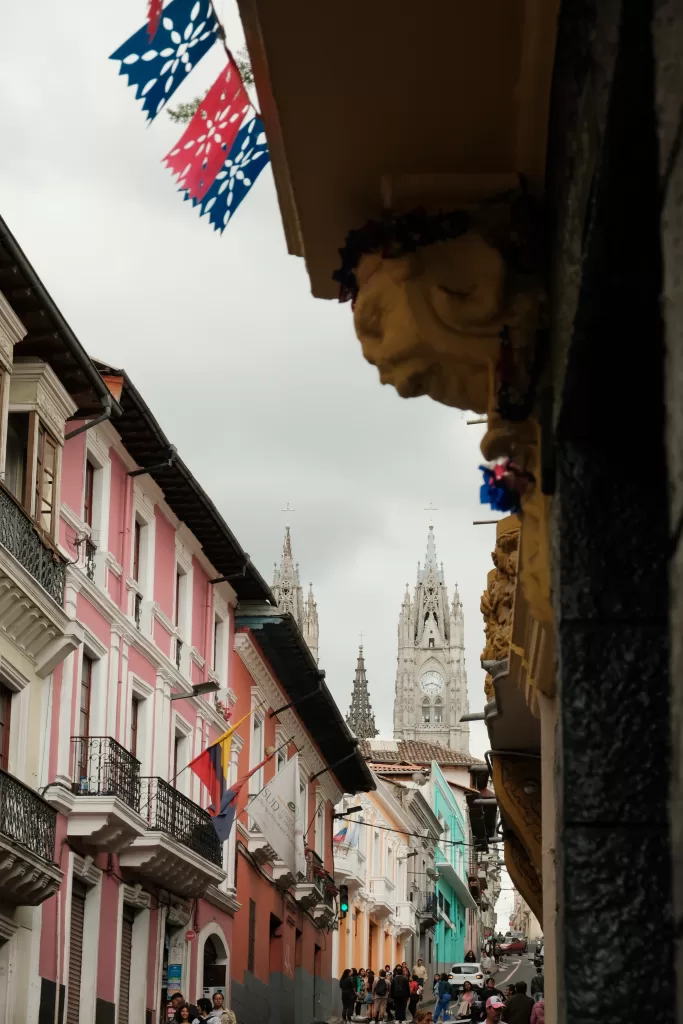
There’s a lot to do in Quito but you can accomplish the major sites in 2 days. If you want time to explore some different neighborhoods, or head out on a guided tour to a nearby cities like Mindo or Otavalo , then plan to stay 3 days instead of 2.
Where to stay in Quito
When choosing where to stay in Quito, you should try to stick to the neighborhoods Centro Historico, La Mariscal and La Carolina, because they are safe and within walking distance to many attractions.
Apartamento 32 Juana de Arco
This apartment is where we stayed in Quito and it was a great option for 4 people. It had 3 bedrooms, a kitchen and a washing machine. It was in a great location, about a 5 minute walk from Plaza de Santo Domingo. I highly recommend it if you’re traveling in a group.
The Secret Garden
If you’re traveling by yourself and plan on going to stay at The Secret Garden Cotopaxi after your time in Quito, you should definitely stay at their hostel in the city. It close to the historic center, there’s a great rooftop, and they run daily tours around the city.
Hotel Patio Andaluz
A beautiful hotel in Centro Historico, housed in a colonial-style building.
Things to do in Quito
Walking tour of the Centro Historico
A walking tour is always a great way to learn about a new city on the day you arrive. We did this free (tip-based) walking tour on GuruWalk and learned about the history of the city, saw the architectural landmarks, tasted Ecuadorian chocolate and got some good tips on where to eat and shop.
Basilica del Voto Nacional
This monumental church in Quito’s historical center is definitely worth a visit. It features neo-Gothic styling and unique gargoyles honoring Ecuadorian animals (you have to look closely!). You can climb the towers for great views of the city.
El TeleferiQo
Quito’s Teleferico takes you up to Pichincha Volcano, which offers stunning panoramic views of Quito and the surrounding mountains. There’s a few different hikes that you can do when you’re up there, which range from less than a mile to 6 miles all the way to the summit of the volcano. You might see some alpacas up there too!
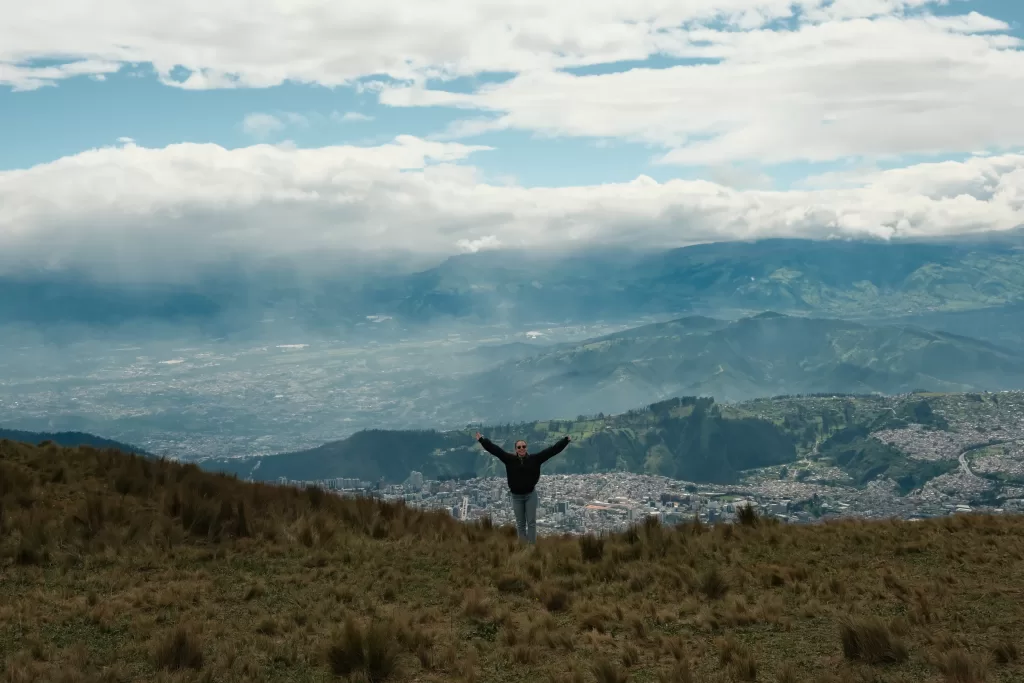
La Mitad del Mundo
This monument, whose name translates to “the middle of the world” marks the equator line, where you can stand with one foot in each hemisphere. You can walk up to the top of the monument and enjoy the informative exhibits in the museum. If you want do some fun equator-related experiments while you’re there, you can also visit the nearby Intiñan Museum.
Virgen del Panecillo
This towering statue of the Virgin Mary sits atop El Panecillo hill and overlooks Quito. It offers panoramic city views which are especially beautiful at sunset. Make sure you take a taxi or Uber there, as walking up the hill can be unsafe.

Cotopaxi
Stay 2 nights
After your time in Quito, pick up your rental car and drive about 2 hours south to stay near Cotopaxi National Park, which is an unmissable stop on your Ecuador road trip. Cotopaxi is a picturesque volcano surrounded by serene landscapes and diverse wildlife, with great opportunities for hiking.
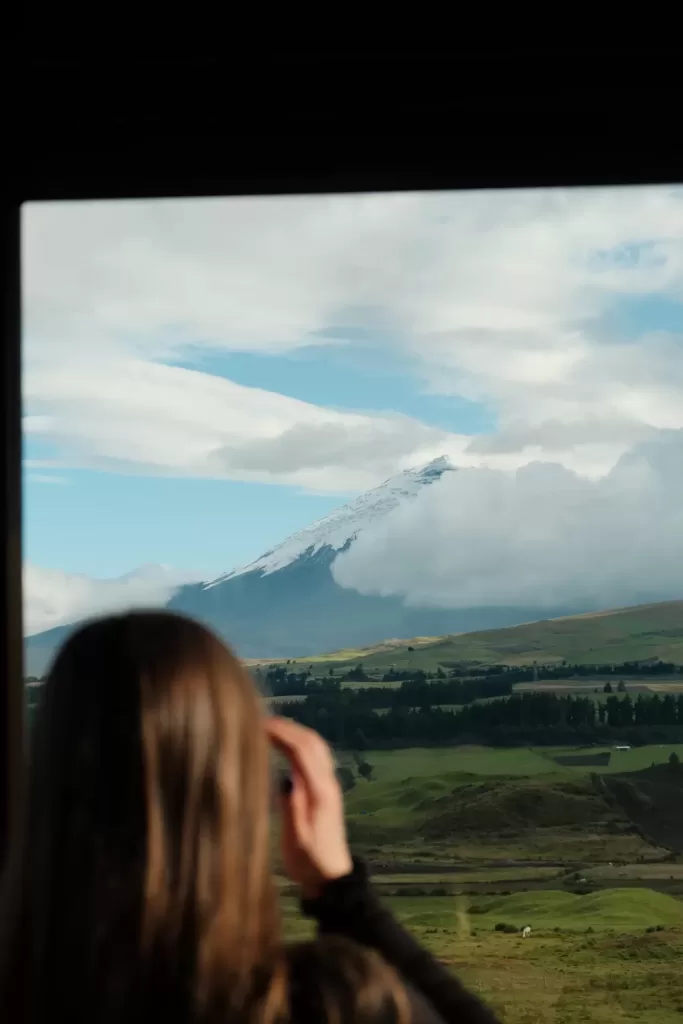
Where to Stay in Cotopaxi
We stayed at The Secret Garden Cotopaxi, and you can read about our full experience here. If you want to have a stress-free trip to Cotopaxi, including a few hikes, spectacular views and delicious meals, I recommend you stay at The Secret Garden. There’s lots of things to do there, which they can arrange for you, including a tour that takes you to Cotopaxi.
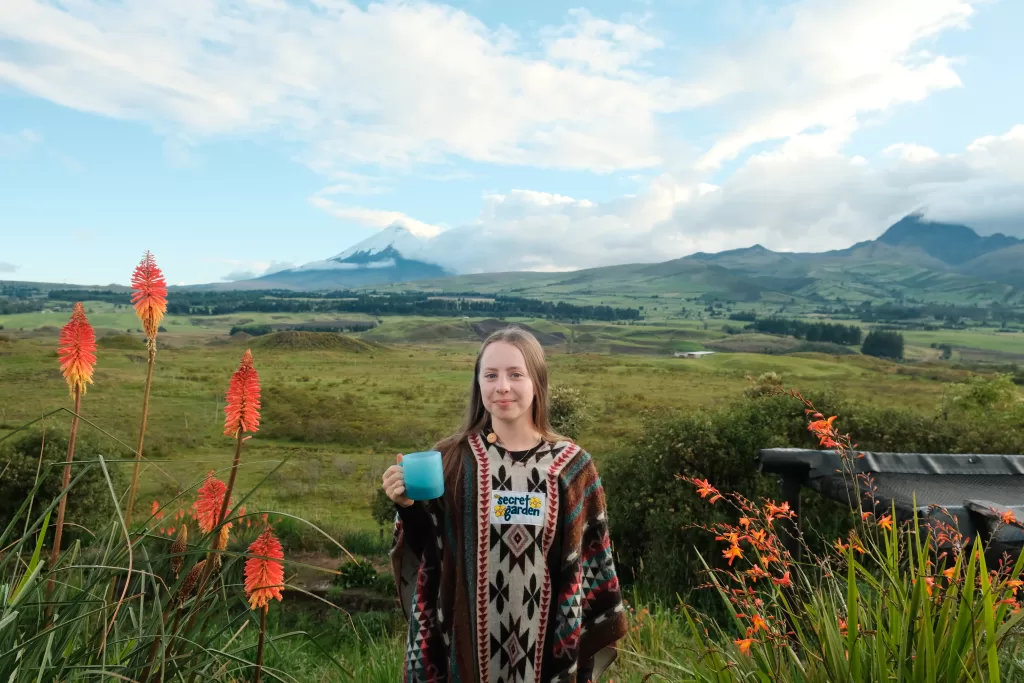
Another accommodation option is the Chilcabamba Lodge, which is close to the entrance of the park and also offers amazing views of Cotopaxi mountain.
Trails to Hike in Cotopaxi
While staying at the Secret Garden, we did a short waterfall hike, a tour to visit Cotopaxi mountain, and a hike to a nearby volcano, all of which were arranged by the hostel.
If you’re not staying at Secret Garden, however, you can also visit Cotopaxi in your own car. The National Park as a North and South entrance, although the South entrance is recommended because it has better road conditions. Once you reach the parking lot (4,500 meters) you can hike up to the José Rivas Refuge (4,864 meters) which takes about 1 hour.
As an alternative and less strenuous hike you can visit Limpiopungo Lagoon, which offers great views of Cotopaxi and opportunities to spot birds and wild horses.
Be aware that the weather is quite unpredictable near Cotopaxi and the mountain is often covered in a thick layer of clouds. If you can’t see Cotopaxi from the bottom, it may also be cloudy at the top with low visibility, so keep this in mind before you make the drive up there. During the two days we were there, Cotopaxi was only visible during the first night, and it rained all of the other days. The views were still beautiful, but only got that iconic view of the top of the volcano for a short time.
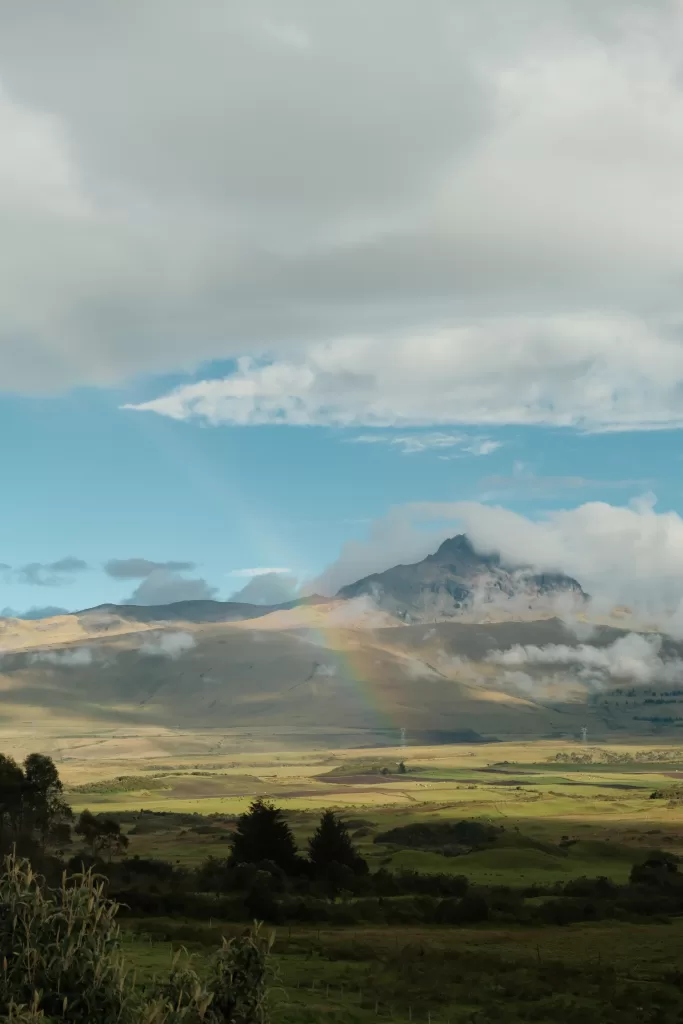
Read my full review of The Secret Garden Cotopaxi here!
Quilotoa
Stay 1 night
From Cotopaxi, you’ll drive about 2.5 hours south to Quilotoa, a small town famous for its emerald green crater lake. Most people visit Quilotoa as a day trip from Quito or Baños, but we decided to add it to our roadtrip and stay the night since it was on the way.
Fill up your car with gas on the way from Cotopaxi to Quilotoa because there are no gas stations in the town. You will pass many while driving through Machachi and on the Pan American Highway.
The town of Quilotoa is tiny, with just a couple of hotels and restaurants, and a handful of souvenir shops. The elevation is very high, at almost 4,000 meters. Compared to where we were staying in Cotopaxi, I felt very affected by the altitude in Quilotoa. I was out of breath from just walking and started to get a headache, likely from altitude sickness. It was also colder in Quilotoa than the other places we visited, so be prepared with a jacket!
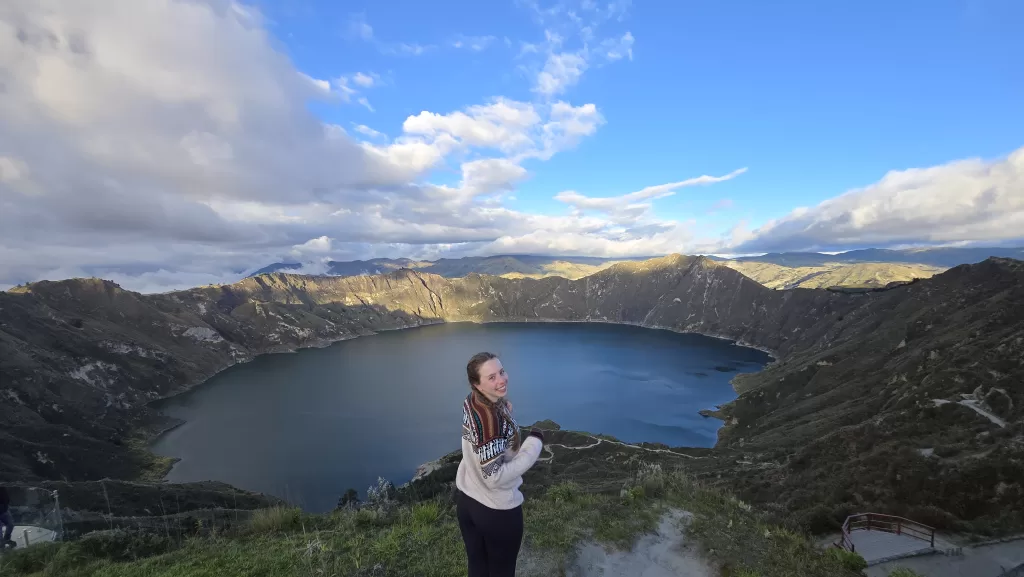
There’s a small fee to enter the town of Quilotoa, which you will be asked to pay when you’re driving in. We were a bit confused when a random lady came running up to us asking for money as we were looking for parking, but she explained it is the per person fee for entering the town. I believe it was about $10 for all 4 of us, but I can’t remember the exact price.
Where to Stay in Quilotoa
Like I said, there’s only a few hotels in Quilotoa. We stayed at Hostería Chukirawa, which has the best location right across the street from the crater. The rooms were basic but comfortable, and our stay included breakfast. There’s a great restaurant at the hotel that a lot of the tour groups seemed to go to for lunch.
The most budget friendly accommodation in Quilotoa is Cabañas Quilotoa, which has shared dorm rooms and private rooms. It’s also in a great location just down the block from the crater.
Trails to Hike in from Quilotoa
Descent to the Lake
The must-do Quilotoa hike is to walk down to the crater lake so you can see the stunning emerald water up close. This hike is pretty easy going down and only takes about 20 minutes. Going up, however, is a lot harder because of the altitude and can take 40 minutes to an hour. Because the hike up is known for being so difficult, there are mules there that you can pay to take you back up.
As an avid hiker, I’m embarrassed to say that I did in fact take a mule back up to the rim of the crater! I was feeling very warn out from the altitude and the hike up seemed impossible since I was out of breath just from walking on flat surfaces. So I paid the $10 for the mule and had a scenic but bumpy ride back up!
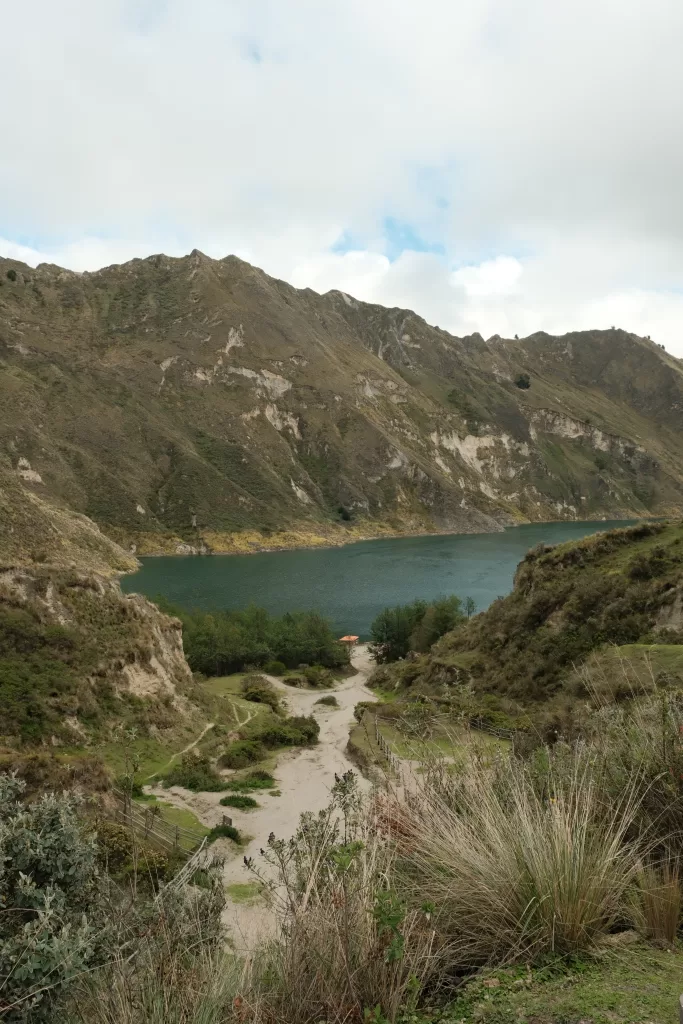
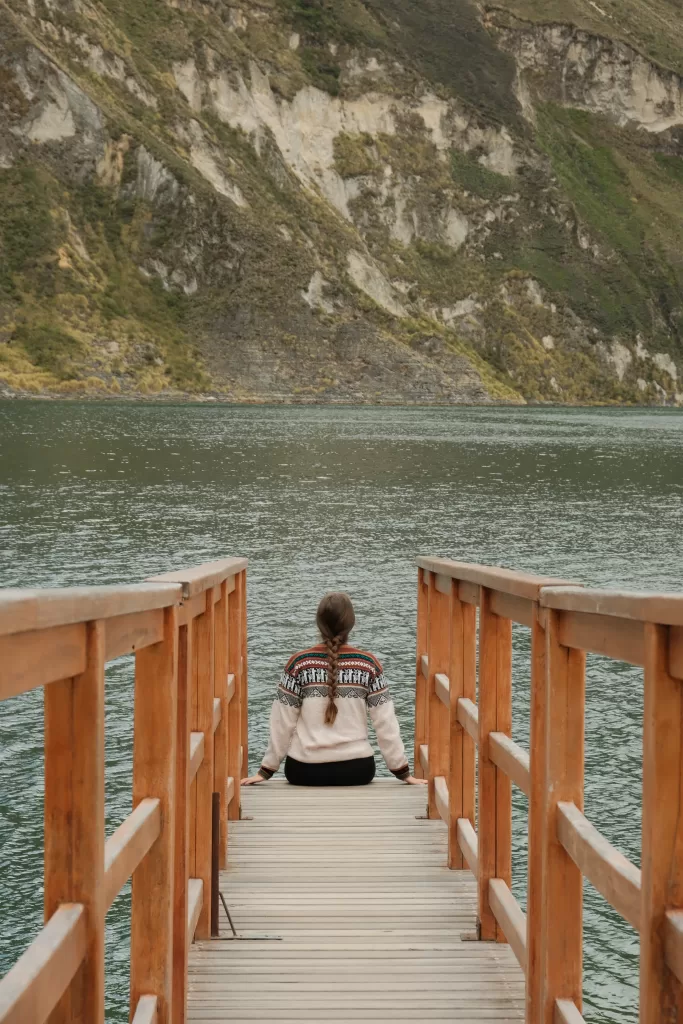

We heard that you can rent kayaks while you’re at the bottom of the crater, but this wasn’t available when we went down. We saw the kayaks there, but there was no one working. It could be because we went pretty early at around 9 am, before the tour groups arrive in the middle of the day.
Hike Around the Rim
If you have some extra time in Quilotoa, hike the 4 to 5-hour loop trail around the crater’s rim for panoramic views of the lake and surrounding Andes. You can also just hike a small section of the rim as an out and back trail. I really wanted to do this hike, but since I was feeling some altitude sickness, we decided to skip it.

Alternative to staying in Quilotoa overnight
If you don’t want to stay the night in Quilotoa, you can also just visit on the way from Cotopaxi to Baños. Leave early in the morning from Cotopaxi and drive 2.5 hours to Quilotoa. Spend a few hours there, hiking down to the crater, eating lunch and walking around the town. Then start your 3 hour drive to Banos. Just make sure you leave a couple hours before dark (the sun sets around 6) because the road is winding and unpaved in some sections.
We decided to stay the night because we didn’t want too much driving in one day. And we ended up really enjoying Quilotoa, especially once all the tourists left! We were one of the only ones staying in the town that night and we felt like we had the whole place to ourselves. On this note, make sure you eat dinner before 6 pm, because that’s when almost all the restaurants close. We waited till 7 and had to search for the only restaurant in town that was still open!
Want to stay connected while abroad?
As a solo traveler, staying connected to the internet is one of my biggest priorities. I always want to be able to find my way around if I get lost or be able to deal with emergencies if necessary. I don’t like to depend on finding wifi, so I always buy eSIMs when traveling internationally. It’s a lot easier than having to buy a physical SIM card, which aren’t compatible with most phones these days.
I use the app Airalo, where you can download eSIMs for 200+ countries. My biggest tip – download and activate the eSIM before you board your flight, so you’ll have internet as soon as you arrive.
Baños
Spend 2 nights
Baños is Ecuador’s adventure capital with endless things to do, from waterfalls and hot springs to zip lining and white water rafting.
I’ll admit, I found the actual town of Baños to be a bit kitschy. If you’ve every visited Niagara Falls or Atlantic City in the US, that’s what I mean by kitschy. It’s not a bad thing, just a little tacky and definitely curated for tourists, but I really liked the kitschy places we went to. For example, there’s a few parks, like Casa de Arbol and El Bosque Encantado, that cost a few dollars to enter and have photo ops and swings. They were both really fun!
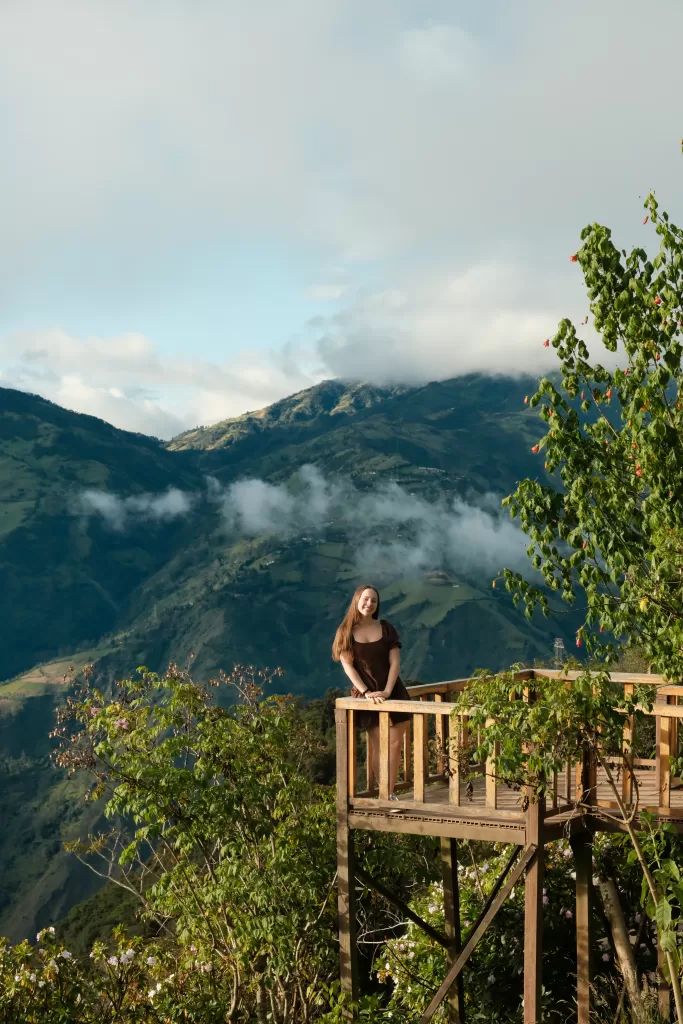
Besides the kitschy things to do, Baños also offers relaxing hot springs, incredible waterfalls, lush greenery and white water rafting. There’s really something for everyone there and enough activities to fill a few days. We stayed 2 nights which was enough time to see the main attractions in Banos, but 3 days is recommended if you really want to do everything.
Where to Stay in Baños, Ecuador
Aldea Real Eco Friendly
We stayed at this beautiful hotel that was about a 10 minute drive outside of Baños. Our room had a balcony, a hammock, and a stunning view of the river. There was a delicious breakfast included as well.
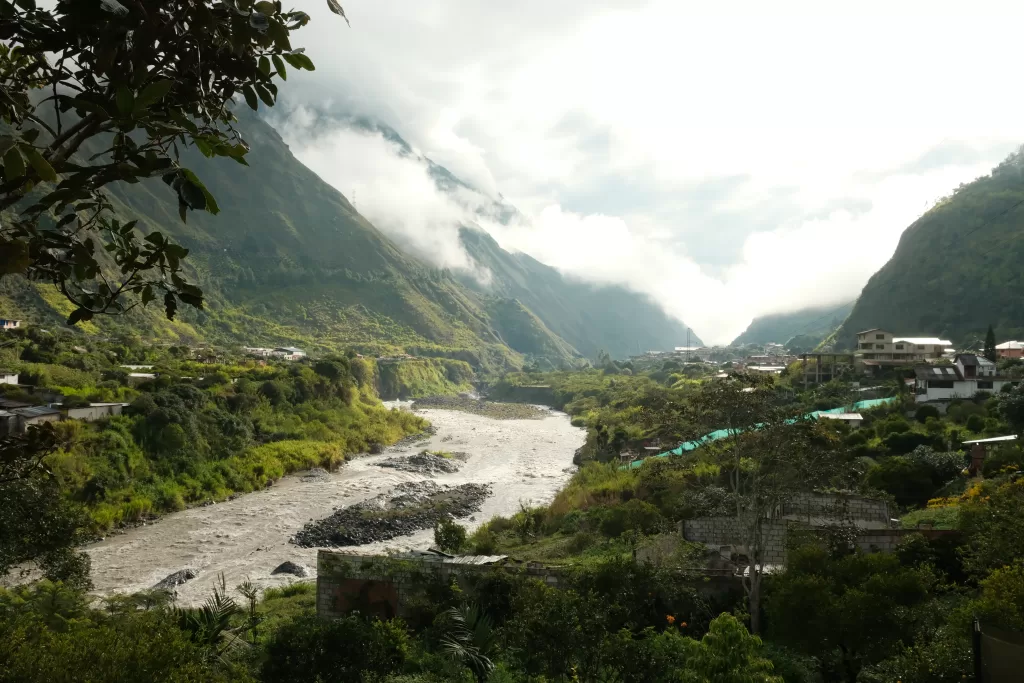
Rústic Quinta La Aurora
This hotel is a good option if you want to stay in the city of Baños, within walking distance to restaurants and a some of the attractions. The room also includes breakfast.
Great Hostels or Erupcion Art Hotel & Hostel
If you’re traveling to Ecuador on a budget, these two hostels both cost about $10 per night, are located right in the city center, and have great reviews on HostelWorld!
Things to Do in Banos, Ecuador
Check out this blog post for a full, detailed list of things to do in Baños, Ecuador.
Termas de la Virgen – Natural hot springs heated by the nearby Tungurahua Volcano.
Paillon del Diablo – This tall and powerful waterfall is a must-visit in Baños.
Casa del Arbol – A small adventure park set in the mountains with a tree house, swings, zip lines and beautiful photo opportunities.

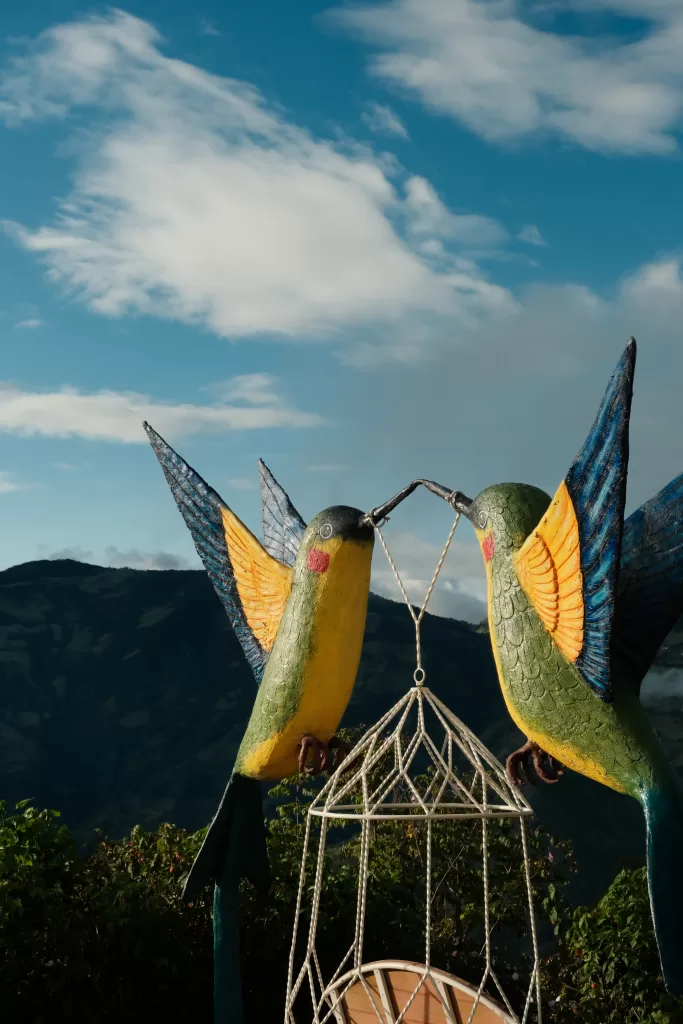
El Bosque Encantado – An “Enchanted Forest” walk through experience with displays and photo ops set up for different fantasy worlds.
White Water Rafting – The best thing we did in Baños, booked here on GetYourGuide.
Read more: 5 Can’t-Miss Things to do in Banos, Ecuador!
Riobamba / Chimborazo
Stay 2 nights
You’re last stop on your Ecuador roadtrip will be Riobamba, which is only about 2 hours from Baños. Riobamba is a charming colonial city and the gateway to Ecuador’s tallest volcano, Chimborazo, which is about 1 hour away. Although Chimborazo is not higher than Mount Everest when measured from sea level, its location on the equator makes it the further’s point from Earth’s center and the closest point to space.
Where to stay in Riobamba
Depending on your preference, you can either stay in the city of Riobamba or closer to Chimborazo. We stayed in Riobamba with my boyfriend’s family who live there, and it was nice to be close to restaurants and the town center. But if you want to be closer to Chimborazo so you can get there as early as possible, then there are a few lodges that are close to the entrance of the park.
In Riobamba, Hotel Spa Mansion Santa Isabella is a boutique colonial-style hotel in the center of the city. Closer to the mountain, Chimborazo Lodge is located inside of the Chimborazo Natural Reserve, so the location couldn’t be any better. It’s offers incredible views and has a restaurant, so you won’t have to worry about going into the city to eat.
Visiting Chimborazo
Wake up early in Riobamba and aim to leave for Chimborazo at 6 am, so you can get there 1 hour before the Natural Reserve opens at 8 am. Because Chimborazo is very popular and everyone visits by car, it’s important to get there early. There are limited spots in the parking lot, so if you get there late you may have to wait until a spot becomes available. We got there at 7 am and there were about 20 cars in line ahead of us.
Once the park opens you’ll be able to drive in. You’ll have to park your car for a few minutes while you wait in line to register. It’s free to enter the park, but you must register by providing a form of ID (I just gave my passport number). There’s also a bathroom near this parking lot if you need it.
Once you’ve registered, get back in the car and start driving to the first refuge, Refugio Carrel. This drive takes about 20 minutes and offers incredible views of the top of Chimborazo and the surrounding landscape. You’ll be driving through the clouds, and once you’re above them if feels like you’re on the top of the world!
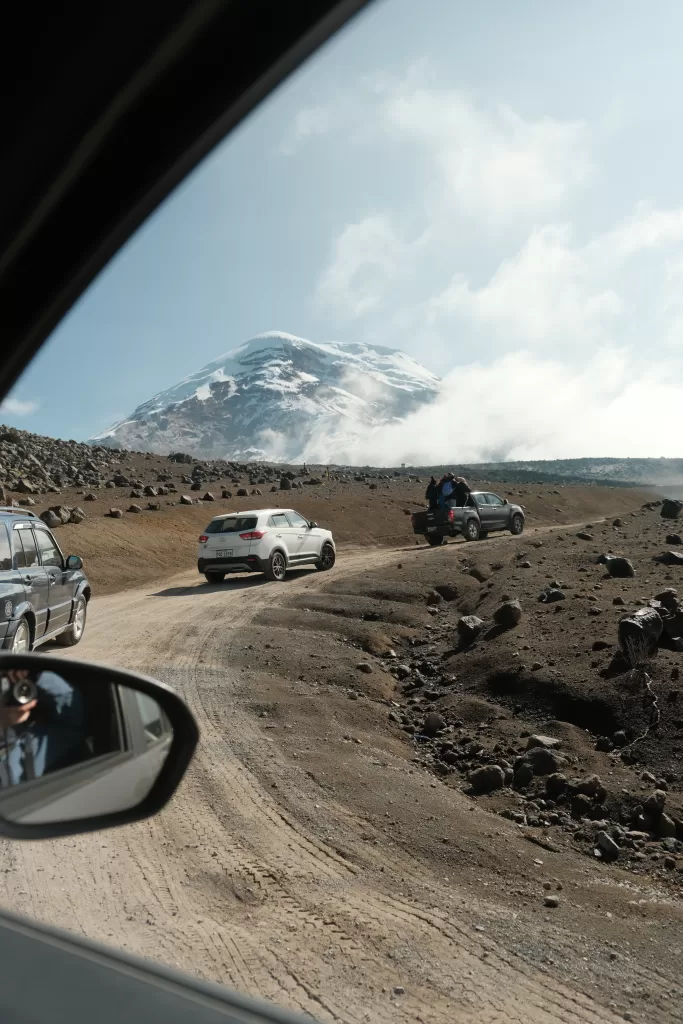
After you’ve parked at Refugio Carrel (4,850 meters) you’ll start your hike to Refugio Whymper (5,000 meters). It’s a short hike but given the altitude and steepness, it’s very hard and can take 30 minutes to an hour. If you’re up for it you can keep hiking past this refuge to get even higher, where you can find a small lake called Laguna Condor Cocha. Many people brought sleds and hiked to a snow slope go sledding.
We were blessed with amazing weather on the day we went to Chimborazo. Once we were above the clouds, the sky was completely clear. So although it was cold, the sun (and the hiking) kept us warm. But you should come prepared with layers, gloves and a hat, as the temperatures can be drastically colder than they are in Riobamba.

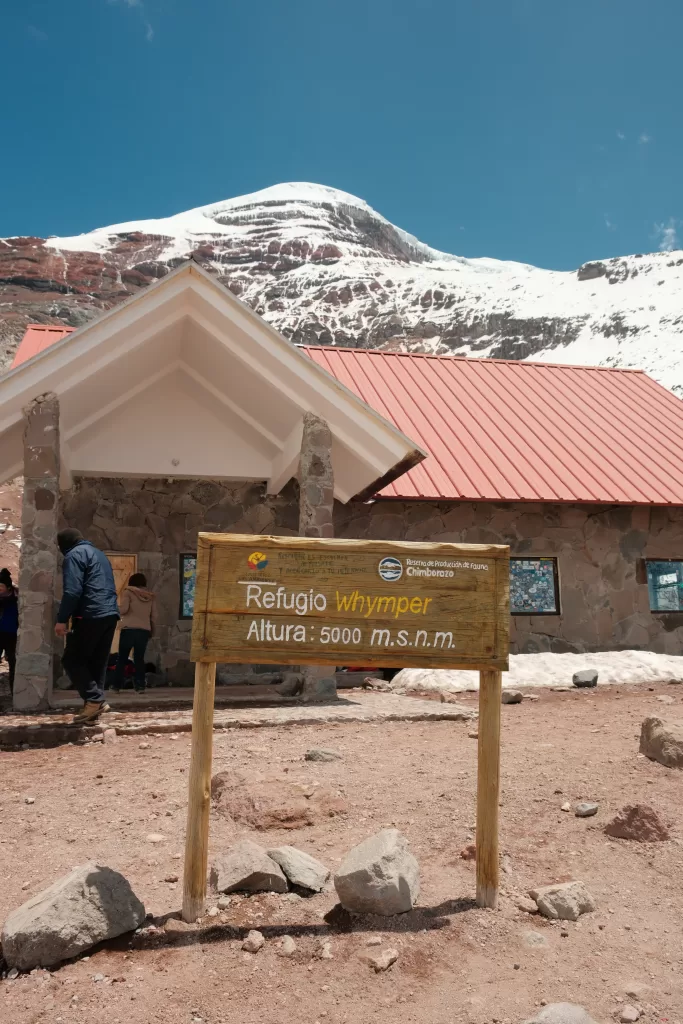
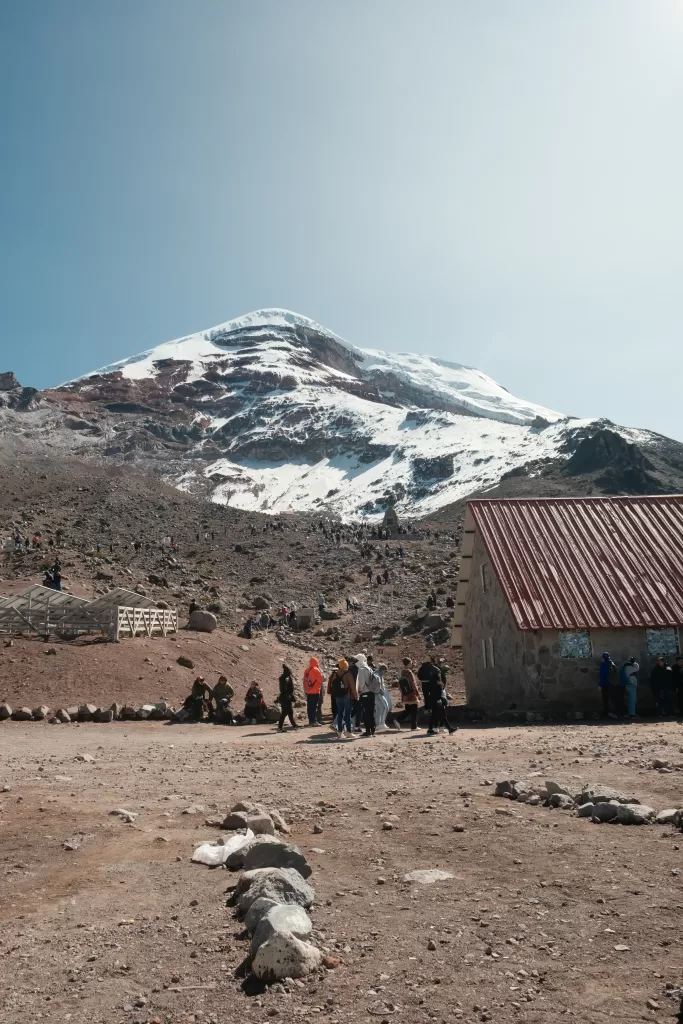
Other Things to Do in Riobamba
If you have some extra time in Riobamba, you should explore the Cento Historico. Visit the Plaza de la Concepción to see the Catedral de Riobamba. If you like museums there’s the Museo de Arte Religioso de la Concepción and the Museo de la Ciudad de Riobamba. To try some local dishes and shop from local artisans, visit the Mercado de la Merced.
Because we were staying with my boyfriend’s family who live in Riobamba, they showed us around the city and gave us a tour of some of the surrounding towns, such as Guano and Colta.
Back to Quito
On your last day in Ecuador, drive back to Quito, which takes 3-4 hours from Riobamba. If you are heading straight to the airport to catch a flight, leave with extra time as there is often traffic around the city. Our drive was delayed about an hour because of an accident on the highway, so we were glad we left with a couple hours to spare.
If you’re flight is early in the morning and you need to stay overnight near the airport, I highly recommend staying at Hotel Alpachaca. It’s a 5 minute drive to the Quito airport and they provide a shuttle for just a few dollars. It doesn’t feel like an airport hotel at all because the surroundings are so beautiful. There’s a rooftop with incredible views of the mountains and the planes landing.
Ready to book your Ecuador roadtrip?
- Use Google Flights or Skyscanner to find the cheapest flights to Ecuador
- Find the best hotels on Booking.com and the best hostels on HostelWorld
- Rent a car from DiscoverCars
- Use GetYourGuide to find walking tours, day trips and unique experiences
- Book airport transfers & tours on Viator
- Stay protected with travel insurance from SafetyWing
- Stay connected to the internet with an eSIM from Airalo
This site contains links to affiliate websites, and I receive an affiliate commission for any purchases made by you on the affiliate website, at no extra cost to you. Thanks!






